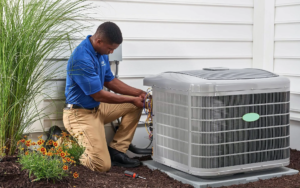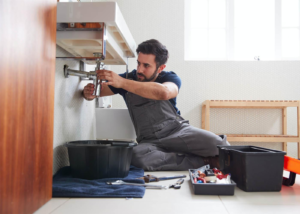Heating, ventilation and air conditioning systems are responsible for heating and cooling homes. They include products like furnaces, air conditioners and heat pumps, as well as ductwork and thermostats.
HVAC system design is important to maximize energy efficiency. Upgrade to equipment with higher SEER, HSPF or AFUE ratings, use programmable thermostats and maintain properly sized systems to reduce energy usage. Contact Hvac Lexington KY now!

HVAC systems use a lot of energy, which is why it’s important to have an efficient system that reduces electricity usage. One way to do this is by scheduling regular maintenance. This includes cleaning or replacing air filters, inspecting and cleaning the coils, and checking refrigerant levels. Another way to lower your energy consumption is by installing a programmable thermostat. This allows you to set a schedule for when you’re home and away, which can save you money over time. Finally, you can reduce your energy consumption by upgrading to a more efficient system. Newer models are designed to use less energy and may be eligible for rebates or incentives from your local utility company.
Many factors affect HVAC electricity consumption, including building occupancy and activity, weather conditions, and occupant thermal comfort. Climate-specific issues, such as hot summers and cold winters, cause HVAC systems to work harder, which increases their electricity usage. On the other hand, mild weather conditions require less energy for heating and cooling, lowering electricity usage.
Other factors that can lead to high electricity usage include a building’s structure, ductwork, and control systems. Oversized or undersized HVAC systems can waste energy by cycling on and off frequently, whereas insufficient insulation can increase air temperature fluctuations and cause the system to work harder. Additionally, poorly sealed doors and windows allow conditioned air to escape and unconditioned air to infiltrate the space, which increases energy usage.
Finally, the use of new technologies that can help to optimize HVAC energy efficiency is a great way to lower electricity usage and make your facility more green. For example, a ductless mini-split system uses less energy than a central system, due to the fact that it doesn’t have any ductwork to lose heat. In addition, these systems can be powered by renewable energy sources to further decrease their reliance on traditional electricity grids.
Uneven Temperature Distribution
When air is distributed unevenly within a building, it can cause different rooms to feel cooler or warmer than others. Addressing this issue can make for more comfortable indoor environments while minimizing unnecessary energy usage. Some ways that this can be done include addressing blocked or closed vents, adjusting the placement of heat-generating appliances, and utilizing duct deflectors to direct airflow.
One common reason for uneven temperatures is the lack of enough air return drops. This is important because the purpose of a HVAC system is to mix and change over air, but if there aren’t enough return drop outlets then this is not possible. Another common reason for uneven temperatures is the fact that heat naturally rises, so rooms on higher levels tend to be a bit warmer than those on lower levels.
Uneven cooling can also be a result of improperly sized or installed systems. An HVAC system that is too small for the space won’t provide sufficient cooling, while an overpowered system can cause short cycling – it will turn on and off frequently, never providing an even flow of cool air to all areas.
If you find that your home’s temperature varies widely from room to room, it may be time for an air balancing service. This is a specialized service that an HVAC professional will perform, but there are some simple DIY fixes you can try first. Check that your air vents are not blocked or closed, and regularly clean your ductwork to avoid leaks. If your home is insulated, consider increasing the amount of insulation to help achieve more balanced temperatures. You can also install smart thermostats with zoning capabilities, which allows for individualized climate control of specific zones or floors of the home.
Noisy HVAC System
A loud, rattling sound is a sure sign that something is wrong with your HVAC system. This could be as simple as debris stuck in your ductwork, or as complex as loose bearings within your fan unit or compressor. Either way, you should shut off your system and call a professional right away.
While some thumping sounds are normal, you should avoid hearing clanking or banging noises when your system is running. This could mean that there is a problem with the blower assembly and should be checked immediately.
Those who want to keep their homes as quiet as possible should consider adding insulation to walls, ceilings, and around ducts and vents. This will help reduce the amount of air that passes through the system, making it much quieter in the home.
Another way to decrease HVAC noise is to install a bypass duct that relieves pressure in a multi-zone system. It is important to consult an HVAC expert who has experience with this type of work before installing a bypass duct.
Other HVAC noises can be caused by closing too many supply ducts, which causes a loss of return air and leads to a buildup of pressure in the ductwork. This can lead to a hissing sound, which is a sign of damage to coolant lines or a refrigerant leak.
The clicking sound is the result of a communication issue between the thermostat and the HVAC unit. This means that the thermostat is trying to send a message to the HVAC unit and is being interrupted. While this might seem insignificant, it should be addressed immediately by an HVAC technician to prevent more serious problems.
Malfunctioning Thermostat
When your thermostat is malfunctioning, it won’t read indoor temperatures accurately. This leads to the system running for short heating or cooling cycles before shutting off again, putting undue strain on your HVAC equipment. The problem can also cause your system to overheat or underheat the space, leading to energy waste.
If your thermostat is not reading your home’s temperature correctly, you can test it by placing a glass thermometer next to the device. If it reads warmer or cooler than your thermostat, this is a sign that the device has lost calibration and needs to be replaced.
In some cases, a thermostat will simply stop working completely. If this happens, you should first check that the power switch is turned on and that the batteries are fresh. If the screen remains blank despite a new set of batteries, it is likely that the circuit breaker has been tripped. This is a common issue that can be easily resolved by checking your main electrical box and resetting the tripped switch.
If you’ve tried the simple troubleshooting solutions above and your thermostat still doesn’t respond, it is time to call in a professional. A licensed HVAC technician will have the tools, electrical knowledge and in-depth experience to get your thermostat up and running properly again. It’s important to schedule regular maintenance appointments for your system and thermostat to keep them in tip-top shape throughout the year. An experienced technician will know how to inspect and clean your thermostat, check and change the batteries, verify the wiring and make any necessary repairs. This will help ensure that your home’s temperature settings remain accurate at all times and reduce your energy consumption.
Dirty or Clogged Filters
Air filters are an important part of a home’s HVAC system. They keep contaminants like dust, mold spores, pollen, pet hair and dander from circulating the home’s air. But they can get dirty and clogged very quickly. This can cause a number of problems that affect the quality of the home’s air.
Dirty filters restrict the amount of air flow through the HVAC system, forcing it to work harder to cool the house. This can lead to overheating and even cause the system to shut down.
Changing the filter is an inexpensive and simple way to save energy and extend the life of your HVAC system. It’s also a simple way to help protect your health and that of your family.
One common indicator of a dirty filter is an increase in allergies, coughing or sneezing. This is because a dirty filter isn’t filtering out dust, dirt or other pollutants and they are being recirculated throughout the home.
Another common sign is a visible layer of dust or debris on the filter itself. This means it is time to change the filter.
Other causes of a dirty or clogged filter include the location of return vents in your home, the size of the filter and the number and type of pets in your home. Pet hair and dander can quickly clog a filter, as well as the ductwork that feeds it. This is why it is very important to regularly vacuum and brush your pet to reduce their shedding. Using the proper size filter for your home’s unique ductwork can also improve your system’s performance. If you have questions about your home’s HVAC system, contact Cool Today for a free estimate and more information on how we can help you.
